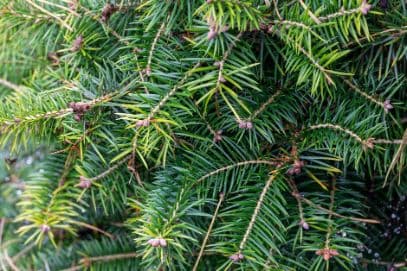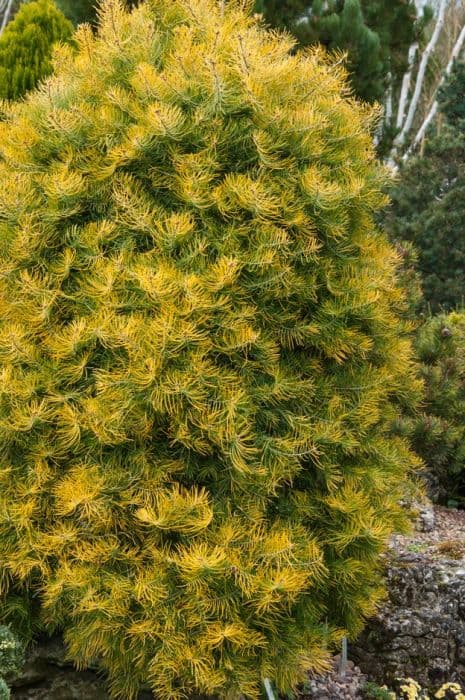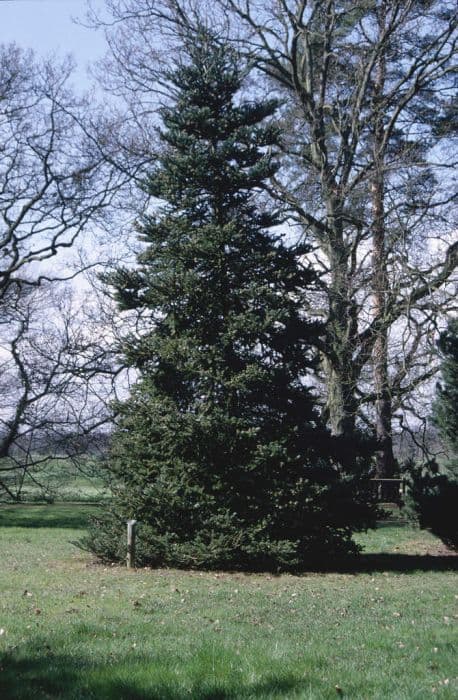Weeping Norway Spruce Picea abies 'Inversa'

ABOUT
The Picea abies 'Inversa', also known as the Weeping Norway Spruce, is a cultivar that displays a very distinctive growth habit. This plant is characterized by its gracefully arching branches that dangle downwards, often sweeping the ground. The branches give the tree an elegant weeping form that stands out in the landscape. The needles of the Weeping Norway Spruce present a deep green color, contributing to its lush and dense appearance. The individual needles are attached to the branches in a spiral fashion, which is typical of the spruces, and they are fairly stiff and pointed, albeit not sharp. This needle arrangement creates a full and somewhat bristly texture. During different seasons, this plant maintains its green color, which might sometimes take on a darker hue in the winter months. The Weeping Norway Spruce also produces cones, which start off as small and with a green or purplish color, maturing to a more woody brown as they age. These cones hang down from the branches, complementing the overall inverted pyramidal to spreading form of the tree. The Weeping Norway Spruce is aesthetically remarkable for its sweeping silhouette, making it a dramatic and attractive specimen for any garden. It's perfect for creating focal points or for use in areas where its unique form can be fully appreciated and allowed to drape naturally.
About this plant
 Names
NamesSynonyms
Weeping Norway Spruce, Inverted Norway Spruce.
Common names
Picea abies 'Inversa'
 Toxicity
ToxicityTo humans
Norway spruce (Picea abies 'Inversa') is not generally considered toxic to humans. There are no commonly reported symptoms of poisoning from ingestions of its parts. However, as with many plants, it is possible for some individuals to experience allergic reactions or gastrointestinal discomfort if they ingest the needles or other parts of the plant. These symptoms would likely be mild and could include nausea, vomiting, or diarrhea. It is always advisable to avoid eating ornamental plants as their safety for human consumption is not guaranteed.
To pets
Norway spruce (Picea abies 'Inversa') is also not commonly known to be toxic to pets. It's unlikely that the ingestion of the needles or other parts of the plant would lead to significant toxic effects. Nevertheless, pets may experience mild gastrointestinal upset such as vomiting or diarrhea if they consume parts of the Norway spruce. Always monitor your pets and prevent them from chewing on ornamental plants, as the fibers and oils can be irritating or cause blockages. If you suspect your pet has ingested a large quantity of the plant and is showing signs of distress, it is best to consult a veterinarian.
 Characteristics
CharacteristicsLife cycle
Perennials
Foliage type
Evergreen
Color of leaves
Green
Height
10 feet (3 meters)
Spread
10 feet (3 meters)
Plant type
Tree
Hardiness zones
3
Native area
Europe
Benefits
 General Benefits
General Benefits- Aesthetic Appeal: The weeping Norway spruce, with its unique inverted growth habit, adds visual interest and a distinctive touch to landscapes.
- Shade Provider: Its dense foliage provides shade in garden areas during hot summer months.
- Wildlife Habitat: Offers shelter and nesting sites for birds and other small wildlife.
- Soil Erosion Control: The root system helps stabilize the soil, reducing erosion on slopes.
- Windbreak: Acts as a natural wind barrier when planted in groups or rows.
- Privacy Screen: Can be used to create a living privacy screen or hedge because of its dense growth.
- Year-Round Interest: Maintains its foliage throughout the year, providing greenery even in winter months.
- Durable: Demonstrates resilience to cold temperatures and adapts to a variety of soil conditions.
 Medical Properties
Medical PropertiesThis plant is not used for medical purposes.
 Air-purifying Qualities
Air-purifying QualitiesThis plant is not specifically known for air purifying qualities.
 Other Uses
Other Uses- Picea abies 'Inversa', commonly known as Weeping Norway Spruce, can be used in bonsai creations due to its unique growth pattern and aesthetic appeal.
- Woodworkers may value the atypical wood patterns for decorative woodworking projects, creating unique furniture or art pieces.
- Since it is a weeping variety, this plant can be trained over structures to create green roofs or living arches in gardens.
- Landscape artists may utilize the Weeping Norway Spruce in topiary gardens, as it can be shaped into interesting forms.
- The drooping branches can be used as a natural privacy screen when planted in rows along property boundaries.
- The tree can be implemented in sound barrier landscaping due to its dense foliage, helping to reduce noise pollution.
- It serves as a natural habitat and nesting site for various bird species, supporting biodiversity in the garden.
- The branches and needles can be used as mulch for gardens to retain soil moisture and reduce weed growth.
- Weeping Norway Spruce can be a focal point in winter gardens for its resistance to snow damage, preserving garden aesthetics in colder climates.
- The tree's unique growth habit can be used in storytelling or educational settings to showcase plant variation and adaptation.
Interesting Facts
 Feng Shui
Feng ShuiThe Norway spruce is not used in Feng Shui practice.
 Zodiac Sign Compitability
Zodiac Sign CompitabilityThe Norway spruce is not used in astrology practice.
 Plant Symbolism
Plant Symbolism- Resilience & Longevity: Picea abies, commonly known as Norway Spruce, is renowned for its ability to thrive in harsh climates, symbolizing endurance and the capacity to withstand challenges over time.
- Growth & Upward Movement: As a fast-growing tree, the Norway Spruce represents continuous growth, aspiration, and progress in one’s life.
- Protection: The Norway Spruce has been traditionally used to make protective structures and as a Christmas tree, signifying shelter and a safe haven.
- Festivity & Celebration: Since the Norway Spruce is often used as a Christmas tree, it brings to mind joy, the spirit of giving, and family gatherings.
- Renewal & Rebirth: The evergreen nature of the Norway Spruce, retaining its needles throughout the seasons, emblemizes renewal, hope, and the cycle of life.
 Water
WaterThe Weeping Norway Spruce requires consistent moisture, but it's important not to overwater. During the growing season, water the tree deeply once a week, providing about 1-2 gallons per session for young trees and more for established ones depending on the tree size and soil conditions. In drier periods without rainfall, you may need to water twice a week. During winter, reduce watering but ensure the soil doesn't dry out completely. Always check that the soil is slightly moist at a depth of a few inches before watering again.
 Light
LightThe Weeping Norway Spruce thrives best in full sun to partial shade. Preferably, it should be planted in a spot where it can receive at least six hours of direct sunlight per day. However, it can also tolerate light shade, especially in areas with hot summers.
 Temperature
TemperatureWeeping Norway Spruce can endure a wide temperature range, from sweltering summer heat to freezing winter conditions. It is hardy and can survive in temperatures as low as -30°F and as high as 90°F, but the ideal growing temperature range is between 60°F to 75°F.
 Pruning
PruningPruning the Weeping Norway Spruce is mainly for shaping and removing dead or diseased branches. It's best to prune in late winter or early spring before new growth starts. Annually check the tree and prune as needed, focusing on maintaining the desired shape and removing any problematic growth.
 Cleaning
CleaningAs needed
 Soil
SoilThe Weeping Norway Spruce (Picea abies 'Inversa') thrives in a moist, well-draining soil mix with a pH ranging from slightly acidic to neutral (pH 6.0-7.0). A mix of loam, peat, and sand in equal parts is often suitable to ensure proper drainage and nutrient retention.
 Repotting
RepottingThe Weeping Norway Spruce rarely needs repotting as it is typically grown as an outdoor plant. In landscape settings, repotting is not applicable. If grown in a container, repotting may be done every few years as needed, carefully avoiding damage to the roots.
 Humidity & Misting
Humidity & MistingThe Weeping Norway Spruce prefers outdoor conditions and is generally tolerant of a wide range of humidity levels. It does not require specific humidity conditions when grown in its natural outdoor environment.
 Suitable locations
Suitable locationsIndoor
Not ideal for indoors, needs sun, space.
Outdoor
Give full sun, well-drained soil, space to grow.
Hardiness zone
2-8 USDA
 Life cycle
Life cycleThe Picea abies 'Inversa', commonly known as Weeping Norway Spruce, begins its life cycle as a seed, typically germinating in spring under suitable environmental conditions. Once germinated, it progresses into a seedling stage, establishing roots and a shoot that will develop into its characteristic weeping form. With growth, the sapling stage sees the development of a woody trunk and branches, with the pendulous branches becoming more pronounced. The mature stage is marked by further growth in height and the spread of its drooping branches, along with the production of cones that contain seeds for reproduction. Cones typically mature in autumn, releasing seeds to complete the reproductive cycle. The Weeping Norway Spruce can live for many decades, continuing to produce seeds annually once mature.
 Propogation
PropogationPropogation time
Late winter-early spring
The Picea abies 'Inversa', commonly known as the Weeping Norway Spruce, is typically propagated through grafting. This method is favored for its ability to reliably produce trees that mirror the distinct weeping characteristics of the parent plant. Grafting is often done in late winter or early spring before new growth begins, taking advantage of the plant’s dormant period. The process involves taking a short piece of a stem with a bud, known as a scion, from a healthy, desirable Weeping Norway Spruce, and joining it to a rootstock of a different tree. The joint is made by cutting matching notches in both the scion and the rootstock and then binding them together until the wound heals and the tissues fuse, usually over several weeks. It's a skilled technique that allows for the continuation of desired traits, and when performed correctly, it results in a new Weeping Norway Spruce that carries the picturesque drooping habit of its source tree.









